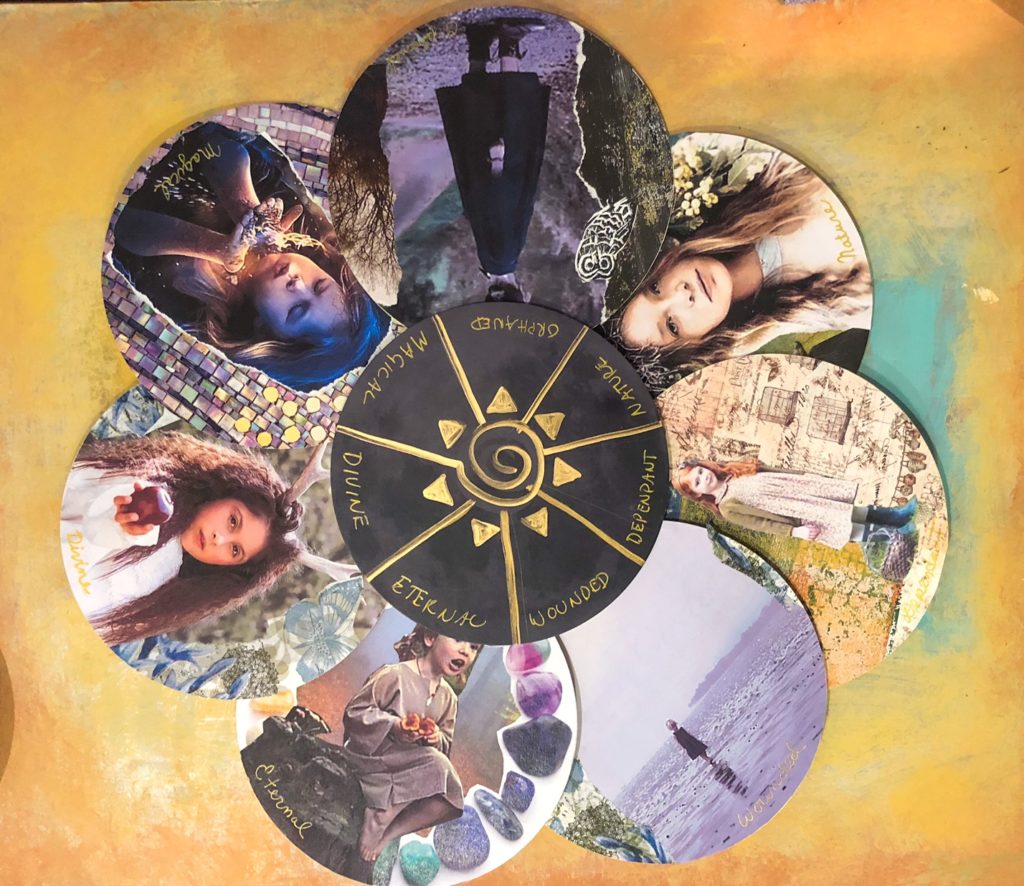
Inner Child Work is always spiraling back around into my life.
As a very quiet, serious, introverted (not shy), creative child who preferred her own inner world to the external world, childhood holds some difficult material for me.
I often avoid this work when called to it, but when I engage with the stories I’m always so glad I did.
The JourneyCircles™️ process offers you ways to restore your stories, to find the ones that never were yours to begin with, let them go and embrace the stories that are authentically yours.
You Can Read more about the JourneyCircles™ Process + watch a video of how to create on a JourneyCircles™ card HERE
During this spiral of working with all of the various inner children, magical, divine, orphaned, wounded etc. I was able to (finally) give creative form to my inner children as I know and experience them instead of through the lens of school, society and family because their story about me wasn’t really my story.
It was more a story of shame, and feeling/being different and therefore not as acceptable. But it took a lot of hard work to undo those labels.
Now I have a council of inner children that are honored and happy and from here on out will be able to contribute in healthier ways to my whole inner being.
Inner child work… hard but worth it.
Brief overview Child Archetypes, see if any of them resonate with you.
The Wounded Child – is wounded from abuse, neglect or other traumas suffered in childhood. This archetype, as a child and as an adult, can often have a deep sense of compassion, understanding and sense the wounds of others because she was wounded herself. Spiritually the Wounded Child archetype often acts as an activator for forgiveness. The shadow may be stuck in self-pity, or blame parents for everything real or perceived. The shadow may also continually seek out parental figures even into adulthood, seeking to fill what was left emotionally unfulfilled in childhood, thus never allowing them to grow into self resourcefulness.
The Orphaned Child – from birth is kept out of the family circle. This may be actual rejection or simply the overwhelming sense of not belonging to their family. They may be different in temperament, an introvert in a family of extroverts, or a dreamer in a family of doers. The Orphaned Child must learn independence early on to survive. Because the Orphaned Child is not part of the family or tribal circle, family influence is far less than normal. Family beliefs, attitudes, expectations, are not powerful factors in her life and this leads the Orphaned Child to create their own inner reality based on their own lived and intuited experiences. The shadow often deeply longs to belong but has difficulty trusting to the point of pushing others away consciously or unconsciously.
The Magical Child– knows that everything is possible. Often highly gifted and creative The Magical Child archetype has the ability to perceive the sacred/divine in all things as well as the energetic web of connection that binds all things together. The Magical Child is often very wise and courageous, able to effect change in their world in ways that seemingly defy the ordinary.
The shadow is often a Wounded Magical Child, whose innate belief in the potential of all possibilities was dismissed or ridiculed as pipe dreams, nonsense, childish fantasies or make believe. Depression may develop as the belief in miracles is lost especially when the adult Magical Child loses hope that what they dream of doing and achieving in their life can never become real.
The Nature Child– is deeply in tune with the natural world. They are at home in the outdoors often possessing an uncanny ability to befriend and communicate with animals and even plants and trees. She may also be intuitively aware of weather, seasonal changes, and the spirit of the land or particular places. They are constantly collecting rocks, feathers, sticks and other treasures gleaned from the earth. The Nature Child often has a deep and powerful urge to grow things. The Nature Child is often very sensitive, yet they can also be amazing resilient just as nature herself is resilient. The shadow may manifest in abuse or neglect of nature or animals or even self. This shadow aspect may be more pronounced in our time as those with this archetype may have less and less opportunity to connect with the natural world and that sense of frustration or isolation results in the very opposite behaviors that are part of their essence.
The Eternal Child – revels in the spirit of youth, retaining their childlike wonder, and energy throughout life. They have an innocence and carefree aura about them. They often take joy in simple pleasures, enjoy unstructured time, freedom to “play” and respite from the demands of everyday life. The shadow resists growing up (Peter Pan) and taking on responsibility for themselves as an adult. This archetype may reject societal norms and live a life outside the structure of the adult world. The Eternal Child Shadow may be overly dependent, and resist or ignore responsibilities. Stuck in a younger stage of life the Eternal Child may stagnate or find themselves ungrounded. No longer a child they drift unable to grow up and function well in the adult world they reject and avoid.
The Needy Child – Like the Wounded Child and the Orphaned Child archetypes The Needy Child has suffered neglect in childhood. They live their lives in pursuit of what was withheld, though it may be unclear exactly what that was/is. Thus The Needy Child never feels satisfied, nothing ever quite fills the void or the ache inside them. The shadow often exhibits depression, feelings of low self-esteem or unworthiness. The Needy Child shadow is self absorbed, focused solely on his or her own unfulfilled needs, oblivious to the needs of others. The Needy Child makes healthy relationships difficult to achieve.
The Divine Child – is usually recognized early on as having an innate relationship to Spirit or the Divine. Their innocent, compassionate, gentle nature and essence seems to resonate on a higher energetic vibration than most other humans. Loving-kindness comes naturally to them. They have a special inborn enlightenment which often draws others to them seeking instruction or healing. This archetype’s shadow may take the form of the Guru, who deceives or dominates his or her followers, wielding spiritual power in dangerous and inappropriate ways.
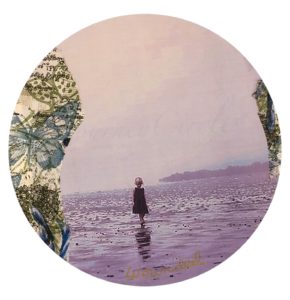
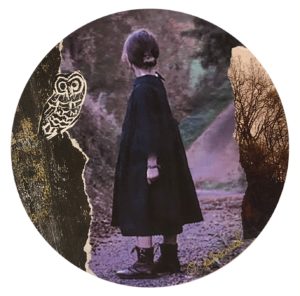
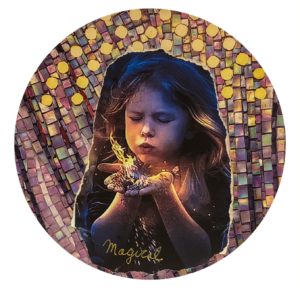

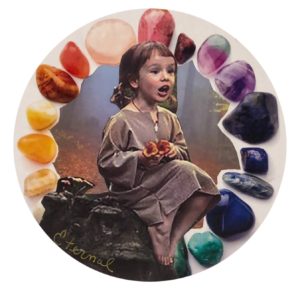

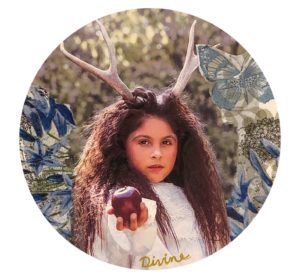
Interesting. Actually fascinating. Is it common to have a variety of combined archetypes?
Absolutely, and almost always.
Reading through these gave me some much needed insight. I believe that I’m a combination of nature and needy child.
Hello!
What were your resources in regards to these specific archetypes? Jung or Myss?
Thank you!
Hello Sarah,
Jung is the primary influence in understanding what archetypes are and how they exist as energetic and psychic patterns that organize behaviors and thoughts in individuals and the collective. I have taken classes on the archetypes with Caroline Myss and gained insights from her, but find her analysis somewhat rigid.
However, that being said, a great deal of my understanding of archetypes comes from my own personal study, experience, and engaging with them in my own work and with clients.
Hope that helps to clarify. ~ jan
I am fascinated, at your approach. As having studied & worked with both modalities, I love you sharing how your Higher Self guided and healed your Inner & Archetypal energies. Thank you.
Caroline Myss does have a rigidness in her descriptions doesn’t she? I’m struggling to narrow down my archetypes to the point it’s ridiculous! I’ve tried being patient..I’ve paused my spot in Sacred Contracts for a month now cuz I intended to take the time necessary to reflect on these energies and I’m more indecisive now then ever. The problem is I relate to them all…like with an intensity in which I repeatedly find myself (with bold enthusiasm) saying “this is the one without a doubt, I just know it!” But then I’m just as excited with feelings of connectedness to them ALL. idk what to do..help!
I feel the same way and understand your frustrations with ‘being all of them’.
Personally I wonder if there is a place for ‘being all of them’, as we incarnate with these aspects to drive and connect Oneness.
‘Being all of them’ is no different as being ‘one of them’ as each incarnation comes with its set of challenges.
What about rather than resisting their existence within, inviting all of them around the table, and listen closely, rather than judging or having to decide which one has earned a plate of food in our consciousness?
❤️